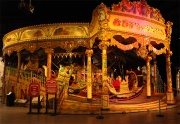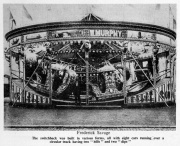



Savages of St Nicholas Works, Kings Lynn
The company built fairground and traction engines, steam wagons and ploughing engines. they also built some fairground locomotives designed to run on a circular track. They also made engines for steam yachts.
1850 Frederick Savage established the business with a forge in the 'Mermaid and Fountain' yard in Tower Street, King's Lynn
1861 Employing 15 men and 14 boys [1]
1863 Moved the business to St. Nicholas Street known as St. Nicholas Works
1865 Frederick Savage constructed his first steam-driven ride; Uriah Cheeseman was reported to have received a set of steam Velocipedes. A Report in the Lynn News suggests that this ride was present at King's Lynn Mart and Oxford St Giles in 1866. The evidence suggests that this was Savage's first such ride.
1868 A set of steam Dobby horses were built for George Twigdon, an East Midland traveller, who already operated a Dobby set.
1871 Employing 58 men and 15 boys [2]
1872 Moved the business to St Nicholas Ironworks on a new site to the north of the town
1875 Making traction engines
c.1880 Savages were regularly producing steam Velocipedes and Dobbies for travelling showmen. The involvement of William Sanger led to the title of "Steam Circus" being adopted.
The partnership of Frederick Savage and William Sanger gave birth to another novelty ride in 1880 when they launched the Sea-on-Land - replicas of seafaring vessels, complete in later designs with sails and rigging and often named after liners of the day, were pitched and tossed by mechanisms beneath their hulls. The earliest versions incorporated another new idea, the traction centre engine, which combined the haulage engine with the central drive. Savages were not the only company supplying this type of machine, John and Henry McLaren of Leeds also built some examples.
During the 1880s several manufacturers competed to try to make the 'stationary' Dobby Horses gallop. In 1885 Savages built their first Platform Gallopers for John Murphy from Tyneside. The same year Messrs Reynolds and King designed the overhead crank system which was improved upon the following year by Tidmans of Norwich.
By the end of the century crank-action Gallopers were being supplied by several British engineers and still remain a popular ride on the contemporary fairground landscape.
1881 Employing 130 men and 31 boys [3]
1881 Frederick Savage granted a patent for roundabouts [4]
1880s Listed as Savage Brothers and then became Savages
1888 Savages designed and constructed the first Switchback, cannibalising an older ride. Their first model was delivered to George Aspland of Boston. The idea proved popular and within a matter of months several important travelling roundabout proprietors, including Greens, Baileys, Studts and Murphys had similar machines. The earliest examples featured plain toast-rack cars, which proved uninspiring to customers and soon were transformed into elaborate chariots at the hands of skilled wood carvers.
1889 George Green, John Green's brother, helped to develop the Switchback Galloper. Virtually a cross between a Switchback and a Platform Galloper, it was built by Savages, although never in large numbers. Despite this, an example was travelled in Scotland by the Wilmots and the ride continued to attend fairs north of the border until the 1930s.
1893 Became a limited company as Frederick Savage and Co
1893 Produced under-type wagon.
Savages began building Steam Yachts, using William Cartwright of West Bromwich's improved patent of 1894 (Cartwright was the first to build a set using upright cylinders). Savage's first set was built for John Collins. The Yachts were often given the names of the latest liners: Lusitania and Mauretania, Cymric and Celtic, although Olympia and Titanic proved short lived names on John Collins’ set.
1893 Savages held a patent for the Razzle Dazzle ride with customers sitting on seats on a circular platform which dipped from side to side as it rotated.
Later examples were built in Hartlepool by the Howcroft Carriage and Waggon Works which proved superior.
1894 The Venetian Gondola was introduced by Pat Collins of Walsall. These Switchback rides, along with their electrified counterpart, the Scenic Railway, were a highpoint of early fairground art and aesthetics, indicating the way forward in reaching for decorative benchmarks. Italian designers and craftsmen were imported at the showmen's expense, and a lavish centre organ became a standard of exuberance.
By 1895 some of the biggest names in the fairground world were travelling Tunnel Railways, many using equipment built by Savage while other engineering firms in the north of the country such as John Fowler and Thomas Green from Leeds also invested in the design of such rides.
1898 Steam engine for a fairground organ. (Exhibit at Birmingham Thinktank museum)
1898 Savage Brothers was registered on 1 July, and carried on the business of engineers, carver and gilders. [5]
Savages, Tidmans and Walkers continued to supply steam driven rides until the outbreak of the Great War and also applied the technology to old ideas and designs which reappeared in slightly different formats. Pat Collins took delivery of a Velocipede as late as 1896 and Reuben Holdsworths' Pigs and Balloons built in 1908 were essentially a Platform Galloper of the 1885 patent with the addition of a counter-rotating top.
1915 Production of 49 Airco DH1 aircraft was subcontracted to them but they had some problems with the delivery of these aircraft.
Post-WWI Demand for new fairground equipment declined. Savages only managed to build a few sets of the old time classic Gallopers, Steam Yachts and Scenic Railways.
c.1930 Savages were in decline by this time but they did build a set of Dodgems for London showman Patsy North.
1949 "The firm of Savages, Ltd., St. Nicholas Works, King's Lynn, was founded in 1850 by Frederick Savage, and throughout the years has been prominent in East Anglia in the production of steam engines and implements for agricultural purposes. It has also at different times during its long existence specialised in traction engines designed for showmen and in various equipment popular at pleasure fairs in the early part of the present century.
To mark its centenary, Mr. Ronald H. Clark, A.M.I.Mech.E., has prepared a history of Savages, Ltd., entitled " A Century of Engineering," and he is to be congratulated not only upon the nature of the material included in the text, but also upon the accompanying illustrations. The brochure provides an interesting record of the contribution made by mechanical engineering to agriculture, road transport and to the "show" industry in the days prior to the general employment of the internal combustion engine for these purposes. Mr. Clark's record, however, has not omitted reference to the firm's more recent activities.
Savages, Ltd., as it enters upon the second century of its existence, engages in the variety of up-to-date engineering tasks associated mainly with agriculture, contracting and other branches of rural industry." [6]
List of Models
| Built | Reg No. | Works No. | Name |
| 1889. | AH 5955 | Eliza | |
| 1891. | No 537 | 537 | |
| Steam Yachts | |||
See Also
Sources of Information
- British Steam Locomotive Builders by James W. Lowe. Published in 1975. ISBN 0-905100-816
- Steam Engine Builders of Norfolk by Ronald H. Clark. Published 1948 by The Augustine Steward Press
- Traction Engine Album by Malcolm Ranieri. Pub 2005
- [1] History of fairground rides










